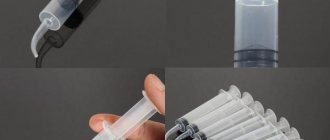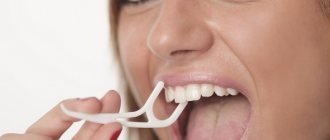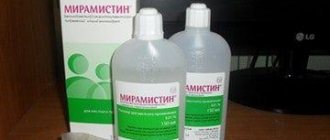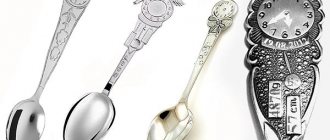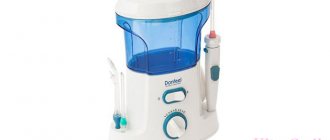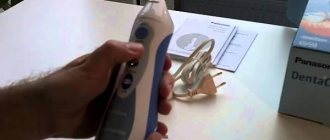Each of us dreams of a healthy and snow-white smile, but in the world of modern technology, an ordinary toothbrush and toothpaste, even the most sophisticated ones, are no longer enough. Dentists never tire of repeating: for complete oral care, your arsenal must include dental floss, rinses and an irrigator, which will replace a whole range of procedures that previously could only be obtained in a dental clinic.
The main task of the irrigator is to maintain oral hygiene. A thin stream of water or special medicinal solutions, supplied under pressure, perfectly cleanses the interdental space (especially in hard-to-reach places), the teeth themselves, gums and tongue, removing food debris, plaque and pathogenic microorganisms. Depending on the selected mode, the water jet can be sprayed, pulsated or supplied continuously. There are practically no contraindications for using an irrigator, with the exception of one thing: children and adults suffering from periodontitis, bleeding and loose gums cannot use an irrigator. You should also refrain from using it if you have recently undergone tooth extraction surgery or installed a denture.
— The main advantage of the irrigator is that its use prevents inflammation of the gums through massage, helps eliminate bad breath and plaque. This is a good prevention of periodontal disease and caries, says dentist Eliza Safarova . – Cleaning with an irrigator helps restore healthy microflora in the mouth; it is also indispensable if you wear orthodontic appliances or have a non-standard dentition. There are no contraindications to using the irrigator. But with great caution, it should be used (or refused during an exacerbation) for people with rosacea, acute periodontitis, recently installed implants or extracted teeth. It is best to use the irrigator in the evening, before going to bed, and do not forget to use an individual nozzle. It is also worth remembering that a waterpik is not a complete replacement for a toothbrush.
The wide variety of irrigators on the market allows you to choose a model that will meet your needs: portable and stationary, with basic nozzles or a bunch of additional options and modes.
Irrigator - a device for cleaning teeth and gums
First, let's figure out what this personal hygiene item is. The irrigator resembles an electric toothbrush with a thin tip instead of bristles. This device operates on the principle of a hydraulic compressor. Pressure is created inside the device, pushing water through the tip under high pressure. The flow of liquid washes away plaque and food particles from the teeth, cheeks, gums and tongue, thereby preventing the development of numerous dental diseases. Some experts do not recommend using the device for patients with problem gums, fearing that it may worsen the situation. However, modern devices, as a rule, have a built-in massage mode that strengthens soft tissues and improves their condition. However, people with acute inflammation should not use the device for some time.
The unique, multifunctional device JETPIK JP200 Elite combines an electric sonic toothbrush, irrigator and dental floss. The components and the device itself are stored in a convenient plastic container, which is ideal for traveling or storing in a small bathroom.
Microbubbles and dental floss
Another distinctive feature of modern irrigators is microbubble technology. Inside the irrigator, the liquid mixes with air, resulting in the formation of bubbles that not only remove plaque, but also destroy harmful bacteria. Typically, a microbubble irrigator with this unique type of jet supply has two operating modes: standard (normal air in) and soft (soft air in), which differ only in pressure force. Another technology worthy of attention is Smart-floss, an exclusive teeth cleaning technique patented by JETPIK. Its peculiarity is that cleaning the oral cavity occurs simultaneously due to the flow of water and dental floss installed in the device. As a result of numerous studies, it has been proven that this technology removes up to 99% of plaque and improves the condition of the oral cavity in the shortest possible time. If you want to have beautiful and healthy teeth and gums, then focus on a “micro-bubble” device or an irrigator with dental floss.
Why do you need an irrigator?
Why do you need an oral irrigator? Firstly, it copes with tasks that many toothbrushes cannot do: it removes plaque not only from the surface of the teeth, but also from hard-to-reach places: interdental spaces, as well as areas between the tooth and the gum. The accumulation of deposits in these areas that are impenetrable to brushing leads to such common diseases as cervical caries, diseases of the periodontal tissues - gingivitis and periodontitis, as well as caries of contact surfaces. Secondly, an irrigator is necessary for owners of braces, dentures, crowns, veneers, lumineers and implants. Such orthopedic or orthodontic structures make oral hygiene difficult and require special care. And finally, thirdly, the stream of water coming out of the irrigator cleans out periodontal pockets and also massages the gums, which helps strengthen them and, as a result, reduce bleeding.
Stationary irrigator Revyline RL 100
An irrigator for home use, which has gained popularity among buyers due to its reliability, power and low cost and has received the well-deserved title of “people's”.
Despite its price, the device has an enviable power for its competitors - the maximum pressure level is 870 kPa. It is possible to choose one of the ten required modes.
The body of the device rests on rubber suction feet, thanks to which it does not slip off smooth surfaces during operation.
The irrigator is indispensable for caring for any orthodontic structures, including braces. The nozzle required for such cleaning (type A) is supplied as standard. If necessary, additional attachments can be purchased in our store.
Varieties
Today there are a large number of irrigators, differing from each other in various parameters. Devices are divided into portable and stationary, powerful and not very powerful, with one or more nozzles and modes, with and without microbubble technology, with a water tank and with a connection to a tap, as well as with built-in dental floss, like JETPIK irrigators, in several times increasing the effectiveness of teeth cleaning. Do not also forget that each device has a certain warranty period, depending on the policy of the manufacturer. Read about how to choose the best irrigator in our other articles.
Reliable and convenient irrigator for the whole family Hydro Floss Kitty Waterjet
Models of oral irrigators
All models are divided into stationary and portable, or road irrigators. The first type of device was developed for use at home by several family members, which is why it is also called a family irrigator. The stationary device consists of a fairly large reservoir and a housing with a control panel, connected by a long hose to the handle of the device. This design has the widest configuration and the largest number of functions. Several operating modes and power levels, several replaceable attachments, as well as built-in compartments for storing them make the device versatile and easy to use. By the way, despite its dimensions, the device does not take up too much space and can easily fit on a sink or bathroom shelf. In addition, some models of stationary devices come with a special mount that allows you to hang it on the wall near the place of use. Almost all stationary irrigators are wired, so when choosing a device, do not forget to compare the length of the hose, wire and the distance from the sink to the outlet.
Portable irrigators are inferior in configuration to non-portable ones, but they weigh less and easily fit in a bag. They are convenient to take on a trip or, for example, to work, which is especially important for those who need to constantly monitor the cleanliness of their oral cavity. Portable irrigators cannot boast of a variety of modes and attachments: such devices have no more than two or three, and the tank volume is only enough for one cleaning. The best irrigator for travelers is JETPIK JP200-Travel. It fits easily into your bag, weighs little, holds a charge for a long time, and the removable hose with a clip allows you to use it anywhere - on the train, on the plane, and even on a hike.
Functional and inexpensive stationary irrigator
How to use an irrigator correctly
At first, it is recommended to set the device to the weakest setting so as not to damage soft tissues and cause pain. During cleaning, the handle of the device should be held at an angle of 90° to the surface of the teeth. You should tilt your head so that the liquid will immediately flow into the sink. How often you need to use an oral irrigator, the number of daily procedures and their duration depend on the individual characteristics of the owner of the device. For some, it will be enough to use the irrigator no more than 3 - 4 times a week for 5 minutes daily, while for others, for example, those who wear braces, crowns, implants or other structures or suffer from crowded teeth, to achieve the desired result, you should wash your teeth at least twice a day for 10-15 minutes. In any case, the plan for using the irrigator must be approved by a specialist.
By the way, some devices have a sensor installed that helps to organize the cleaning process correctly. Based on the time given to him, he independently plans the course of the procedure and “informs” his owner when he needs to move from the treated area of the oral cavity to the untouched one.
The Panasonic Dentacare Handy EW 1211 portable irrigator is one of the best devices in terms of reliability.
Types of irrigators
Irrigators are stationary and portable. For home use, it is better to choose a stationary one - it is more reliable and will last longer. Some of these devices can be mounted on the wall. This is useful if you have limited sink space.
If there is no outlet in the bathroom, you can choose a portable irrigator - it runs on a battery and can be charged anywhere. A portable irrigator is lighter and smaller than a stationary one, and is convenient to take on trips.
The first important parameter for choosing an irrigator is the power of the water jet.
.
A portable irrigator must have a power of at least 520 kilopascals (kPa), and a stationary one must have a power of at least 550 kPa. The second selection parameter is the number of jet pulsations
per minute. The optimal value is 1200 pulsations.
Irrigators also differ in their mode switching
. For stationary ones, mode switching occurs smoothly, for portable ones - stepwise. If the waterpik is used by children or people with gum disease, it will be more difficult for them to adjust the comfortable power on a portable one.
Comparison of popular models
To help you make the right choice, we have prepared comparison tables of stationary and portable irrigators. All important characteristics of the devices are listed here.
Stationary irrigators
| Waterpik WP-100 E2 Ultra | Revyline RL 100 | Waterpik WP-660 Aquarius | Revyline RL 500 | Aquajet LD-A8 | B.Well WI-922 | Donfeel OR-820D Compact | Donfeel OR-840 AI | CS Medica AquaPulsar CS-2 | |
| Tank volume, ml | 650 | 600 | 650 | 600 | 500 | 600 | 600 | 600 | 500 |
| Number of nozzles | 7 | 7 | 7 | 7 | 5 | 7 | 8 | 5 | 5 |
| Guarantee | 2 years | 2 years | 2 years | 2 years | 1 year | 2 years | 1 year | 1 year | 2 years |
| Power | from 70 to 690 kPa | from 210 to 870 kPa | from 70 to 690 kPa | from 210 to 870 kPa | from 290 to 810 kPa | from 207 to 827 kPa | from 100 to 650 kPa | 80 - 680 kPa | from 150 kPa to 850 kPa |
| Number of pulsations, min | 1400 | 1200-1700 | 1400 | 1200-1700 | 1200 | 1250-1850 | 1250 — 1550 | 1250 — 1700 | from 1100 to 1600 |
| Wall mount | No | No | No | No | There is | No | No | No | There is |
Portable irrigators
| Waterpik WP-450 | Revyline RL 450 | Philips Sonicare AirFloss Ultra HX8381/01 | Panasonic EW-DJ40 | Panasonic EW1211A | Revyline RL 200XL | B.Well WI-911 | B.Well WI-912 | CS Medica AquaPulsar CS-3 Basic | |
| Tank volume, ml | 210 | 240 | 15 | 165 | 130 | 300 | 150 | 150 | 130 |
| Number of nozzles | 4 | 5 | 1 | 1 | 2 | 2 | 2 | 5 | 2 |
| Guarantee | 2 years | 2 years | 2 years | 2 years | 2 years | 2 years | 1 year | 1 year | 2 years |
| Power | from 310 to 520 kPa | from 130 to 760 kPa | 390 and 590 kPa | from 200 to 590 kPa | from 210 to 700 kPa | 275 - 620 kPa | 378 - 720 kPa | up to 590 kPa | |
| Number of pulsations, min | 1450 | until 1700 | 1400 | 1400 | 1400-1800 | 1600 | 1420 | 1200 — 2000 |
How often should you use a waterpik?
Experts differ in answer to this simple question. The only thing that dentists are unanimous about is that it all depends on the condition of the oral cavity and for what purpose you are going to use the irrigator - preventatively or as part of complex therapy.
For healthy teeth
If you take care of your teeth and do not neglect daily personal hygiene, then it is enough to use the irrigator once a day for 4 days a week - solely for the purpose of preventing the formation of tartar in hard-to-reach places.
For people with bad habits
For heavy smokers, as well as those who like to abuse black coffee, tea or red wine, who are prone to the formation of dense plaque, dentists recommend using an irrigator 2 times a day every day as the final stage of oral hygiene.
During pregnancy
Women expecting a baby are extremely susceptible to any infection. Therefore, to prevent the activation of bacteria that cause caries, an irrigator is indispensable at least once a day.
For gum diseases
If you have chronic inflammatory gum diseases, such as periodontitis or gingivitis, the frequency of use of the irrigator, especially a special periodontal attachment, should be regulated by the periodontist who is observing you.
When wearing braces
Modern brace systems, despite their dramatic progress compared to the designs of 20 years ago, require increased hygiene. In this situation, it is advisable to use an irrigator after each meal during the day.
If you have dentures
The situation is similar with any removable dental prostheses: the more often and thoroughly their hygiene is carried out using an irrigator, the better and longer they will last.
Attention!
After undergoing surgical interventions in the oral cavity, the use of an irrigator should be abandoned until the time when the attending physician allows it.
Tips for choosing an irrigator
When deciding to purchase a particular irrigator, dentists advise paying attention to some important parameters.
Water supply mode
The simplest mode is mono-jet, with a constant flow of water . This type of feed is available in every model, but its effectiveness is sometimes insufficient.
The pulsating jet creates a pulsation with micro-impacts, ensuring quick disposal of food residues even in places where cleaning is difficult. This mode is especially indicated for cleaning the bracket system. It is recommended that the selected model have this mode.
The microbubble system is another modern effective mode that involves mixing a stream of water with air bubbles. When the jet comes into contact with the surface being treated, the air bubble bursts, leading to the occurrence of microhydraulic shocks. This method ensures effective removal of food debris and plaque. In addition, the oxygenated composition promotes antibacterial treatment.
The force of the jet must be adjusted in the irrigator device. This is caused by the need to start cleaning with minimal pressure and gradually increase power. This is especially important in the presence of gum inflammation, as well as for children's oral cavities.
Types of nozzles
When choosing a model, pay attention to the presence of various attachments for it: universal or special, designed for use in specific cases. Most attachment kits are standard and are the same across many models. Of particular interest is a special orthodontic attachment . Its design is characterized by curved shapes and increased sharpness, allowing you to clean the area around the brackets installed on the back teeth. Thus, cleaning your teeth and braces will be complete and thorough.
Rules for caring for the device
The irrigator, like all electrical appliances, requires special care. The device should be washed as follows: firstly, do not under any circumstances immerse the entire irrigator in water, especially when it is turned on - it may short out (which is deadly!), and its parts may rust. Secondly, do not use unboiled water to clean the device, only filtered and, preferably, warm water. Otherwise, scale will form inside the mechanism, which will lead to its breakdown. In order to thoroughly clean the irrigator, you need to fill it exactly halfway with warm water, empty the reservoir after a couple of minutes, rinse the device and nozzles for the irrigator, and then wipe all components dry. Particularly advanced manufacturers produce devices together with a UV sanitizer designed to disinfect replaceable attachments. The ultraviolet radiation on which it works destroys microbes accumulated on the tips and thus prevents the development of dental diseases. As for the storage conditions of the irrigator, it should be kept in a dry place. Touching the appliance plug with wet hands is strictly prohibited.
In principle, the irrigator should not be cleaned too often, except for those cases when you pour special decoctions into its tank. Particles of herbs from the infusion remain inside the device and may damage its operation.
Multifunctional irrigator OR 820M Donfeel with nasal attachment
What is the best oral irrigator?
In order to understand which irrigator is better to buy, you should read reviews and make comparisons. After studying numerous sites, reviews and articles on the topic “How to choose an oral irrigator?”, as well as testing models, we compiled our own review. Today there are a huge number of companies producing irrigators. However, as in any market, there are leaders who create the highest quality devices. The devices produced by all of the above organizations deserve attention, but it would be unwise to purchase them all at once. To make it easier for you to choose an irrigator, we have compiled a 2022 Irrigator Rating, which clearly demonstrates which irrigator is better.
How to choose a liquid for an irrigator?
When using the irrigator, special attention should be paid to the cleaning agent. Usually, irrigators come with a special balm that should be added to the water in the tank. The type of balm and the level of its concentration in water will depend on the condition of the oral cavity and the presence of certain dental problems. Some people pour regular rinse aids into the tank, but they foam quite a lot and make the cleaning process difficult. You can also use ordinary water as a cleaning agent, but only filtered water - it is safer and does not contain impurities that settle inside the device and interfere with its operation. Remember: if there is no water in the container, the irrigator cannot be turned on.
It is important to remember that it is not enough to buy an irrigator and think that it will save you from using conventional hygiene products! The device will provide a final cleaning of your teeth, removing what the toothbrush couldn’t handle. And the supplement will improve blood circulation, stimulate the renewal of soft tissues, prevent the formation of tartar and eliminate bad breath. Our Irrigator Rating 2022 will help you choose the right model.
Which irrigator is better to choose?
Before you begin choosing the most suitable irrigator, it would be a good idea to first consult with your dentist. The range of irrigators is very large, because of this, difficulties often arise.
The main criteria that you should pay attention to when choosing an irrigator for home use:
- Water pressure (power) . This criterion determines how well the device will clean the oral cavity. The stronger the water pressure, the more effective the use of the irrigator.
- Number and types of attachments included . If a person wears braces or has sore gums, then it is worth taking care in advance about the availability of special attachments. More expensive models of irrigators can boast of a wide variety of attachments and built-in operating modes.
- Tank volume . In this case, we are talking more about the ease of use of the device. Reservoirs with a small capacity are inconvenient because they need to be filled with water at intervals of 30-40 seconds. It is better to give preference to large containers; cleaning the oral cavity will be more productive.
- Design feature . There are stationary and portable models of irrigators. In this case, a person must individually determine his goals and choose a more preferable option.
- Type of jet . Water from the tank can be supplied in various ways, a combination of them allows you to achieve the greatest efficiency. More often than usual in irrigators, water is supplied by microbubble and pulsating type.
- Equipment . Of course, a large set of additional accessories expands the functionality of the irrigator, but if necessary, they can be purchased separately.
- Pulsation frequency . If the irrigator supplies water in a pulsating manner, then it is additionally important to understand the frequency of the blows. It is a big advantage if this frequency can be adjusted independently.
The benefit of the irrigator lies in the versatility of its use. It is suitable for regular use, as well as for the prevention and treatment of oral diseases. Dentists recommend giving preference to irrigators rather than ultrasonic brushes if a person develops/has gingivitis, periodontitis, periodontal disease, malocclusion, etc.
To simplify your search for a suitable option, you should familiarize yourself with the rating of the best irrigators in 2022.
Features of use
During the period of wearing braces, only irrigators are able to provide the necessary care for the oral cavity. And no other device can do this better than them! But this does not mean that they can completely replace toothbrushes.
Important! First you need to brush your teeth with a regular brush, and only then use a irrigator.
Since the nozzle is a replaceable part, the irrigator for braces is not a device for personal use. One device can be used by several people.
Recommendations when using the irrigator:
- Before using the device, it is necessary to determine the condition of the teeth and gums. It can only be used if the oral cavity is healthy.
- It is necessary to start with the weakest water pressure. The gums must get used to the procedure. During initial use, sometimes even healthy gums may bleed slightly. But you shouldn’t be scared; it takes time for your gums to get used to the massage and become stronger. Usually 1-2 weeks of regular use is enough.
- Be careful about the temperature of the water used: it should not be higher than 40°C. This will save you from burns to the mucous membrane and unpleasant sensations if there are areas of damaged enamel on your teeth.
- The nozzle head must be held at an angle of 90° to the surface to be cleaned.
- If you have braces, crowns, bridges and other artificial structures, you must use the device at least 1-2 times a day, or better yet, after each meal.
- For minor inflammation of the gums, dentists recommend using antiseptic solutions. It is better not to use regular rinse aids as they foam. Manufacturers offer special products for irrigators.
- Do not use herbal or saline solutions, as they contaminate the device system and shorten its service life.
Important! The irrigator should not be used during periods of exacerbation of diseases such as periodontal disease, gingivitis, acute periodontitis, etc.
Benefits of use
Despite the high cost of irrigators, their purchase is justified. The obvious benefits are noted and highly appreciated by experts. Using such a device allows you to:
- Clean hard-to-reach places efficiently.
- Eliminate unpleasant odor that appears as a result of poor oral cleansing.
- Provide prevention of caries, various gum diseases, protects against the formation of tartar.
- Ensure healthy gums thanks to the massage performed during brushing.
- To facilitate care in the presence of implants and various prosthetic structures in the oral cavity.

